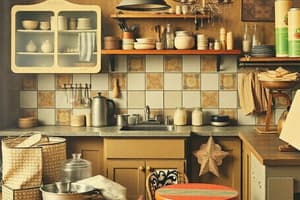Podcast
Questions and Answers
What is the primary reason for maintaining food safety practices?
What is the primary reason for maintaining food safety practices?
- To prevent foodborne illnesses (correct)
- To enhance the aesthetic appeal of food
- To reduce preparation time
- To improve food texture
Which practice is essential for preventing cross-contamination in a kitchen?
Which practice is essential for preventing cross-contamination in a kitchen?
- Storing raw and cooked foods together
- Thawing food on the kitchen counter
- Using the same cutting board for all food types
- Using separate cutting boards for meat and vegetables (correct)
What is the ideal internal temperature for safely cooking poultry?
What is the ideal internal temperature for safely cooking poultry?
- 165°F (correct)
- 150°F
- 140°F
- 180°F
Which mixing method is commonly used for incorporating air into batter?
Which mixing method is commonly used for incorporating air into batter?
What is the purpose of sifting flour in baking?
What is the purpose of sifting flour in baking?
Why is it important to preheat an oven before baking?
Why is it important to preheat an oven before baking?
What technique is used to prevent a pie crust from becoming soggy?
What technique is used to prevent a pie crust from becoming soggy?
Which of the following is NOT considered a leavening agent?
Which of the following is NOT considered a leavening agent?
What is the proper method to thaw food safely?
What is the proper method to thaw food safely?
What is the purpose of glazing or icing in food presentation?
What is the purpose of glazing or icing in food presentation?
Flashcards are hidden until you start studying
Study Notes
Food Safety And Hygiene
-
Importance of Food Safety
- Prevents foodborne illnesses
- Ensures quality and freshness of food
-
Personal Hygiene
- Wash hands thoroughly with soap before handling food
- Use gloves when necessary
- Maintain clean clothing and hair restraints
-
Kitchen Hygiene
- Regularly clean and sanitize surfaces and utensils
- Separate raw and cooked foods to avoid cross-contamination
- Store food at appropriate temperatures (below 40°F for cold storage, above 140°F for hot food)
-
Food Handling Practices
- Keep food covered when not in use
- Use separate cutting boards for meat and vegetables
- Thaw food safely in the refrigerator or under cold running water
-
Temperature Control
- Cook foods to safe internal temperatures (e.g., 165°F for poultry)
- Use thermometers to check food temperatures
- Regularly monitor holding temperatures of hot and cold foods
Baking Techniques
-
Basic Baking Methods
- Mixing: Methods include creaming, folding, and whisking
- Kneading: Important for developing gluten in bread dough
-
Leavening Agents
- Yeast: Used in bread for fermentation, creates air pockets
- Baking Powder and Baking Soda: Chemical leaveners, create gas when combined with liquids
-
Baking Tools and Equipment
- Oven: Must be preheated for even baking
- Mixers: Stand mixers and hand mixers to incorporate air into batter
- Pans: Different shapes and sizes affect baking time and texture (e.g., dark pans absorb more heat)
-
Temperature and Timing
- Follow recipes for precise baking times and temperatures
- Use toothpicks or cake testers to check for doneness
-
Common Baking Techniques
- Whipping: Incorporating air into egg whites or cream
- Sifting: Aerating flour and removing lumps
- Blind Baking: Pre-baking a pie crust to prevent sogginess
-
Presentation
- Glazing, icing, and decorating techniques enhance visual appeal
- Use fresh ingredients for garnish and flavor enhancement
Food Safety and Hygiene
- Food safety practices are essential for preventing foodborne illnesses and ensuring the quality and freshness of food.
- Personal hygiene is crucial. Always wash hands thoroughly with soap before handling food, wear gloves when necessary, and maintain clean clothing and hair restraints.
- In the kitchen, regularly clean and sanitize surfaces and utensils. Separate raw and cooked foods to prevent cross-contamination. Store food at appropriate temperatures: below 40°F for cold storage and above 140°F for hot food.
- Good food handling practices include keeping food covered when not in use, using separate cutting boards for meat and vegetables, and thawing food safely in the refrigerator or under cold running water.
- Cook foods to safe internal temperatures, such as 165°F for poultry. Use thermometers to check food temperatures and regularly monitor holding temperatures of hot and cold foods.
Baking Techniques
- Basic baking methods include mixing, kneading, and various techniques like creaming, folding, and whisking. Kneading is important for developing gluten in bread dough.
- Leavening agents are essential for creating light and airy baked goods. Yeast is used in bread for fermentation, creating air pockets. Baking powder and baking soda are chemical leaveners that create gas when combined with liquids.
- Baking tools and equipment play a significant role. Ovens must be preheated for even baking. Mixers, such as stand mixers and hand mixers, are used to incorporate air into batter. Different pan shapes and sizes affect baking time and texture, with dark pans absorbing more heat.
- Accurate temperature and timing are key for successful baking. Adhere to recipe instructions for precise baking times and temperatures. Check for doneness using toothpicks or cake testers.
- Common baking techniques include whipping, which incorporates air into egg whites or cream, sifting to aerate flour and remove lumps, and blind baking, which pre-bakes a pie crust to prevent sogginess.
- Presentation enhances the visual appeal of baked goods. Glazing, icing, and decorating techniques add finishing touches, while using fresh ingredients for garnish adds flavor and visual appeal.
Studying That Suits You
Use AI to generate personalized quizzes and flashcards to suit your learning preferences.




